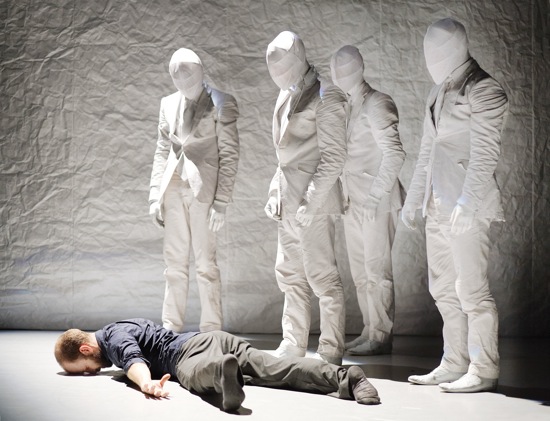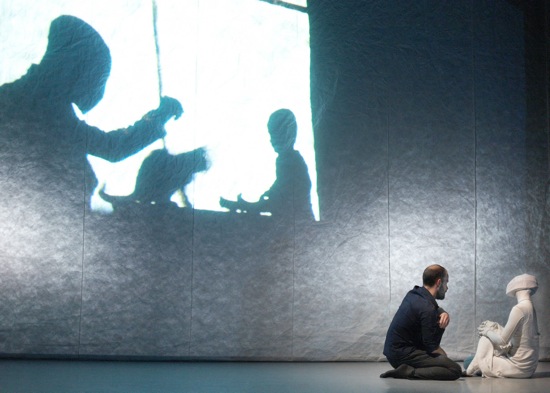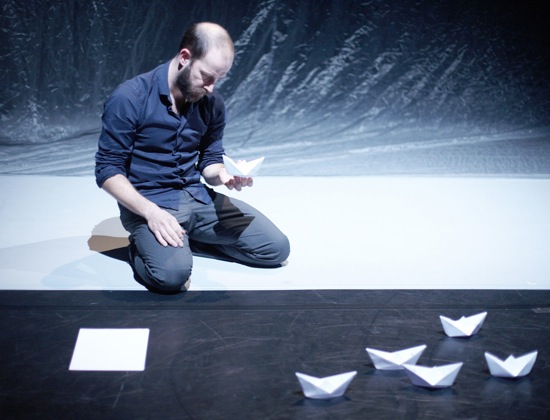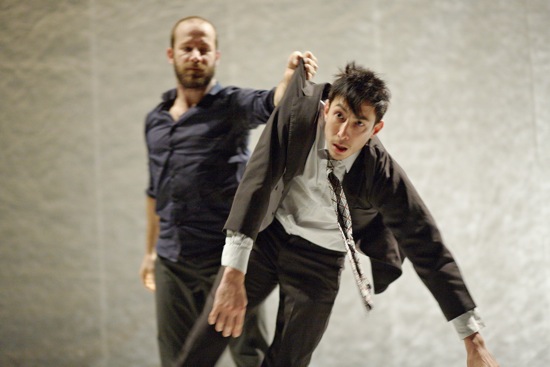
Prospero (Eric Beauchesne) regarded by some of the “replicas” at the end of Kidd Pivot’s The Tempest Replica by Crystal Pite. Photo: Geörg Baumann
I don’t think of myself as purist about Shakespeare. I’m fine with Laurence Olivier inserting a line from Christopher Marlowe’s Tamburlaine into his Henry V film and loved David Gordon’s Dancing Henry V. I’m okay with the 1995 film of Richard III that equates its murderous dynasties with the Third Reich. I relished a years-ago Shakespeare and Company production of Much Ado About Nothing that was laid in a Banana Republic, and I tolerated (just) Kenneth Branagh’s presentation of Love’s Labour Lost as a musical. I’ve sat through Romeo and Juliet ballets ranging from marvelous to tacky.
But I’m baffled by Crystal Pite’s 2011 The Tempest Replica for her Canada-based company, Kidd Pivot—in part by her choice of this most philosophical of Shakespeare’s plays to turn into dance, omitting all nuances of the characters’ motivations. In her wonderful Dark Matters (2009), Pite made brilliant use of puppets, and it’s perhaps inevitable that she would see Shakespeare’s Prospero as a kind of puppeteer, using his magic powers to manipulate the enemies who years ago set him and his tiny daughter, Miranda, adrift in a boat. Now, the ruler of a more or less deserted island, he aims to regain his title as Duke of Milan from his usurping brother and wed Miranda to a king’s son.
In the first part of The Tempest Replica, as seen at the Joyce Theater, Prospero has copies of seven of the play’s characters to maneuver into a happy ending. Although Eric Beauchesne as Prospero is dressed in nondescript contemporary work clothes, the four other male characters wear white shoes, shirts, and business suits; their hands are gloved, and their entire heads covered with white masks shaped like outsized, streamlined bike helmets (costume designer: Nancy Bryant). These personages are the King of Naples (Jirí Pokorny shares the role with Jermaine Maurice Spivey); his son, Ferdinand (Spivey); his brother, Sebastian (Bryan Arias); and Prospero’s traitorous brother, Antonio (Yannick Matthon), with whom the king is in league. Miranda (Cindy Salgado) is similarly swathed (but with a skirt). So is Prospero’s resentful, conniving slave, Caliban (Pokorny), and his devoted sprite Ariel (Sandra Marin Garcia). They all resemble well-kept mummies, and tend to move jerkily at Prospero’s magical commands or as a result of Ariel’s tricks.
While the audience is entering the Joyce during Kidd Pivot’s 11/29 through 12/1 run, Prospero kneels at the front of the stage, folding sheets of paper into a fleet of little boats. When the house lights dim and Ariel enters (not yet masked), he gives her one. This presumably is his way of commanding this temporarily indentured spirit to conjure up a phantom storm that will cast his enemies safely ashore on his island (at a distance from Ferdinand, whom he plans as a husband for Miranda). Ariel takes the paper boat, crumples it, and jams it into her mouth. Crash! Pow! Owen Belton’s score kicks in with the sounds of disaster—splintering timbers, lashing waves, breaking glass.
Now begins the evening’s most theatrically rousing scene. Set designer Jay Gower Taylor, projection designer Jamie Nesbitt, and lighting designer Robert Sondergaard have indeed created a storm. Behind wind-tossed seas projected on a thin, rippling curtain and amid flashes of lightning, the four travelers reel and stagger and fall and grab onto one another. When it’s over Beauchesne pulls the curtain down and wads it up.

Prospero (Beauchesne) “telling” Miranda (Cindy Salgado) the tale of his forced exile. Photo: Geörg Baumann
Pite treats this first part of The Tempest Replica as a kind of further boiled-down Cliff Notes version of Shakespeare’s plot—minus a number of characters, and with few subtleties. The tale of treachery that brought Prospero and the child Miranda to the island years ago unfolds in a brief, not very clear little film peopled by silhouetted figures. Anyone who doesn’t know the play and hasn’t read the program synopsis might be baffled. The live action is similarly succinct, the movements jerky. Prospero brings up Miranda by getting her to copy his gestures. Caliban shows his status by groveling at Prospero’s feet and being kicked away. Prospero moves Miranda’s legs, one at a time, to make her walk to where Ferdinand is. One look at each other’s blank white faces and the two kiss. Oh, no! Too soon! Prospero freezes Ferdinand. The labor he then devises for his son-in-law-to-be is simply moving one white rock, which is immediately pulled back to its original place (one nice touch: the young prince, unused to labor, keeps getting one hand caught under the heavy rock he’s setting down, and he has to tip it to extricate his fingers).
With similar brevity, Pite reveals through gestures such matters as the sorrow of the king, who believes his son drowned, and the conversation in which Antonio tempts Sebastian to parricide. Belton’s score, with the help of sound designers Alessandro Juliani and Meg Roe, not only keeps echoing and blustering around them; it provides creaks, crashes, the metallic clash of a sword being drawn, and other sounds to point up gestures. The projected letters that announce each act and scene we’re about to watch succeed one another rapidly. When we need more clueing into the history of the various relationships, we’re given projected silhouettes (Caliban, saved by Prospero once tried to rape Miranda, hence his slave status). Despite its brevity, this stretch of Shakespeare in dumbshow is far longer than Shakespeare’s crucial pantomime in Hamlet.
In the second part of The Tempest Replica, the characters—now unmasked and in ordinary clothes—are occasionally helped along by a spoken line of text from the play or a projected one. But in watching this part, I begin to hunger for subtleties that might enrich those white mannequins that sped through the plot. It’s not just Shakespeare’s poetry I crave, but his insights into character.
In Pite’s choreography, emotions tend to trigger violent dances. Dancers hurl themselves at the air, at each other, at the floor—their arms flailing, their legs whipping around. The movement doesn’t reveal much more than rage and suffering, except in a sweetly playful duet for Miranda and Ferdinand. Also, the audience hasn’t had time to attach the “live” characters to their replicas. Clearly it’s Arias as Caliban who dances monstrously and is violently subdued by Prospero. But I am not always sure who’s agonizing with whom. At one point, I think for several moments that Prospero is combatting a doppelganger. And what is Ferdinand upset about? The fact that he thinks his father the king drowned? Just when you expect the waters to run deep and rinse the characters into full-colored life, the plot hits the shallows and only reveals them as terrifically skilled and expressive dancers.
There are some provocative and/or magical effects in Pite’s Tempest. At one point, the shipwreck is rewound. In the second part, Miranda runs to the downstage corner and agonizes over the sinking that she sees in the distance, just as her replica did (this time, however, Prospero comforts her). But Pite also plays perplexing games with contemporary allusions. The Miranda and Ferdinand replicas jive at their wedding to suitable music. In the second part, a cocktail party replaces the magical disappearing banquet that Ariel makes happen (via projections) in the first part. A doorbell rings, sirens pass. Once, Ariel struts along on tiptoe, and the sound score mimics the sound of the high heels she’s not wearing. How cool is that? But why?
The first glimpse we have of Miranda in The Tempest Replica is of her lying face down in an awkward position. She’s asleep; Prospero awakens her. But at the end of the piece, when Shakespeare’s island ruler abjures his magic, Pite has the four men—garbed again as replicas—enter and, after a brief skirmish, lift Prospero and lay him down in the same position in which Miranda slept. Then they stand and look down at him. Is this the playwright drained of life by the efforts of his genius? Perhaps. The Tempest is arguably considered to be Shakespeare’s last play, and he died about five years after writing it. Or maybe this moment is Pite’s visualization of lines from Prospero’s great Act IV speech about life and theater: “We are such stuff/ As dreams are made on; and our little life/ Is rounded by a sleep.” Poetry comes in many guises. Would that there was more of it in Pite’s Tempest.



Fascinating. Unlike Deborah, and most of my colleagues, I loathed Dark Matters, and suspect I would loathe this as well. Although Dark Matters was worth sitting through for Spivey’s solo , I hasten to add.
I don’t know why artists from different disciplines from drama have to keep mucking around with The Tempest; Peter Greenaway’s Prospero’s Books comes to mind, although like Deborah I on the whole don’t mind some “adjustments” to Shakespeare–the Oregon Shakespeare Festival does this all the time. They did a re-setting of A Winter’s Tale in Fascist Italy nearly forty years ago that was perfectly viable; I still remember it after all. And a Thanksgiving night discussion of two opera versions I haven’t seen didn’t make me want to rush to buy a ticket. Anyway, this sounds like a self-indulgent piece that needed editing at the very least.
Thank you, Deborah, as always for your generous insights & your sharp descriptions. The Tempest does seem undanceable (Northrop Frye said it resembles operas–The Magic Flute, say–more even than other plays), yet Stephen Petronio made for his company a remarkable piece inspired by the play in 2009, called I Drink the Air Before Me. It’s not at all an adaptation of the play, but rather an evocation of its magical moods in continuous, shape-shifting movement that makes us imagine what it must have been like to be one of the king’s party landing on this strange island.
I’ll add to Martha’s list of failed Tempest adaptations Paul Mazursky’s film Tempest, with its dour Prospero figure, played by John Cassavetes. Yet it does have Raul Julia as a TV-addicted Caliban and, best of all, Susan Sarandon (the Ariel figure[!]) & Molly Ringwald (Miranda) in a synchronized swimming number as they harmonize on “Why Do Fools Fall in Love?”